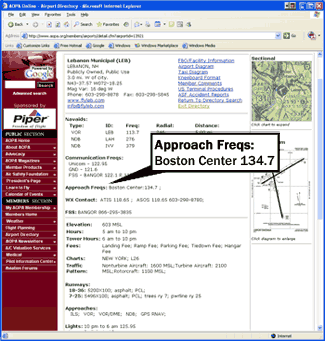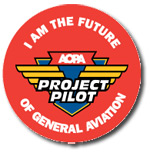| This ePilot Flight Training Edition is sponsored by

Advertisers
            
Do not reply to this e-mail. Got news? Contact ePilot. Having difficulty using this service? Visit the ePilot Frequently Asked Questions now at AOPA Online or write to [email protected].
Aircraft Owners and Pilots Association
421 Aviation Way
Frederick, MD 21701
Tel: 800/USA-AOPA or
301/695-2000
Copyright © 2007 AOPA. | Training Tips
| | VFR FLIGHTS AND ARTCCs
Airports that are served by radar approach/departure controls, and the course segments between them, are not the only kind of airspace where a VFR pilot can receive radar service from air traffic control (ATC). The air route traffic control centers (ARTCCs), whose primary function is to serve flights operating under instrument flight rules, also will gladly handle VFR flights on a workload-permitting basis. How do you go about using ARTCC radar service on cross-countries? A student pilot inquired about that in the March 10, 2006, AOPA ePilot. This is  the answer: "If you want to contact an air route traffic control center (ARTCC), you can find a listing of frequencies for a particular region in the Airport/Facility Directory. Using the A/FD legend on the back cover can help you to quickly find the specific section that contains the list. The ARTCC frequencies in lightface type are designated for low-altitude operations." Also, as shown in AOPA's Airport Directory Online, you can look up a destination airport's communications frequencies and see which ATC facility provides the service. For example, the tower-controlled Lebanon, New Hampshire, airport's approach/departure frequency is 134.7 MHz with radar service provided by Boston Center. the answer: "If you want to contact an air route traffic control center (ARTCC), you can find a listing of frequencies for a particular region in the Airport/Facility Directory. Using the A/FD legend on the back cover can help you to quickly find the specific section that contains the list. The ARTCC frequencies in lightface type are designated for low-altitude operations." Also, as shown in AOPA's Airport Directory Online, you can look up a destination airport's communications frequencies and see which ATC facility provides the service. For example, the tower-controlled Lebanon, New Hampshire, airport's approach/departure frequency is 134.7 MHz with radar service provided by Boston Center. When transitioning to ARTCC radar service from a departure controller, the wording of the instructions you receive indicates whether you have been "handed off" to the ARTCC, or if you will have to establish that contact yourself. "The clue to the pilot that a handoff has been made is the fact that he is never advised 'radar service terminated.' When the pilot checks in on the new frequency, he should do so fully confident that the new controller knows who he is," wrote Robert I. Snow in the September 2004 AOPA Pilot feature, "Loud & Clear: What's ATC trying to say?" He added: "But hearing the words 'radar service terminated' is one key that the next controller has no knowledge of you. Being told to squawk VFR is another." There are many services available to the VFR pilot who knows how to obtain them. Make use of them for safe, efficient flights.
| Your Partner in Training
| | The big day-checkride day-is almost here! Are you ready? Have you reviewed the Private Pilot Practical Test Standards? Have you sat down with your instructor to fill out your FAA Form 8710-1 and gone over your training aircraft's logbook to be sure all the required entries are in place? These are just a few of the details to remember, but you'll get through it. AOPA's Interactive Form 8710 is a great tool to help you with the required FAA paperwork. It takes you step by step through the form and, when completed, can be printed, signed, and given to your designated pilot examiner. Have a question? Call our experienced pilots-available weekdays between 8:30 a.m. and 6 p.m. Eastern to answer your questions toll-free at 800/872-2672. As an AOPA Flight Training member, you have access to all of the features within AOPA Online and AOPA Flight Training Online. Login information is available online.
| Flight Training News
| | 2007 CFI OF THE YEAR ANNOUNCED
Michael G. Gaffney, a Master CFI who instructs in St. Louis, Missouri, has been named the 2007 CFI of the year by the General Aviation Awards executive committee. Gaffney is president and chief education officer of Skyline Aeronautics at Spirit of St. Louis Airport. He designs courses specializing in technology integration in the cockpit that meet the requirements for FAA/Industry Training Standards. Gaffney has written a series of articles for AOPA Flight Training pertaining to technically advanced aircraft. An aviation safety advocate, he recently became a member of the FAA's new FAA Safety Team (FAAST) program, and he conducts numerous safety seminars annually. FAA Administrator Marion Blakey will present the national awards in July at AirVenture in Oshkosh, Wisconsin. The annual GA Awards is a cooperative effort between the FAA and 12 industry sponsors, including AOPA, the Experimental Aircraft Association, the National Business Aviation Association, and Women in Aviation, International. NOMINATIONS OPEN FOR AEROSPACE TEACHER OF THE YEAR
The National Aviation Hall of Fame is accepting nominations of outstanding aerospace educators for the A. Scott Crossfield Aerospace Education Teacher of the Year Award. The award is named for the late aviator, who was the first man to successfully fly at speeds of Mach 2 and Mach 3. Read a profile of Crossfield from the November 2003 issue of AOPA Pilot. The contest is open to classroom teachers of grades K through 12 from any public, private, or parochial school. The chosen educator will be honored in July at the Hall of Fame induction ceremony, and he or she will receive a $1,000 cash stipend. The deadline for nominations is May 25. EMBRY-RIDDLE SUMMER ACADEMY OFFERS AVIATION PROGRAMS
Embry-Riddle Aeronautical University's Daytona Beach, Florida, campus will sponsor a number of aviation and aeronautical-themed programs during this year's Summer Academy. Programs are available for students ages 12 to 18 and are held June 11 to August 9. Selections include the Aviation Discovery for Women course, designed for female students ages 15 to 18 with an interest in aviation and aerospace, and Aviation Career Exploration, in which students use simulators to sample various aspects of aircraft maintenance, air traffic management, engineering, flight, human factors, meteorology, and space technology. There are also three SunFlight programs that offer flight instruction.
| Inside AOPA
| | WIN $5,000 FOR FLIGHT TRAINING FROM AOPA PROJECT PILOT
Are you signed up as a student through AOPA Project Pilot? If not, find a pilot who  can mentor you and come to Sun 'n Fun in Lakeland, Florida, next month. If you and your Mentor sign up for Project Pilot on site at the gate from April 17 through 20, you will get in free for a day (a $30 value), and you'll be given a red sticker to wear. Make sure you have the sticker displayed prominently-AOPA's SurPRIZE Squad will be surprising four lucky winners each day from Tuesday, April 17, through Friday, April 20, with $250 for flight training. Then at the end of Friday, one of those 16 winners will win $5,000 for flight training. (See the official rules for more details.) If you forget to sign up at the gate, swing by AOPA's Big Yellow Tent to become a Project Pilot student and get a sticker for a chance to win money for flight training. can mentor you and come to Sun 'n Fun in Lakeland, Florida, next month. If you and your Mentor sign up for Project Pilot on site at the gate from April 17 through 20, you will get in free for a day (a $30 value), and you'll be given a red sticker to wear. Make sure you have the sticker displayed prominently-AOPA's SurPRIZE Squad will be surprising four lucky winners each day from Tuesday, April 17, through Friday, April 20, with $250 for flight training. Then at the end of Friday, one of those 16 winners will win $5,000 for flight training. (See the official rules for more details.) If you forget to sign up at the gate, swing by AOPA's Big Yellow Tent to become a Project Pilot student and get a sticker for a chance to win money for flight training. DEVELOP DECISION-MAKING SKILLS WITH AIR SAFETY FOUNDATION
Aeronautical decision making is one of the most important skills you can develop as a student pilot, and it is one skill that you should always strive to sharpen, no matter how high you advance through the ranks of pilots. The AOPA Air Safety Foundation created the Weather Decision Making DVD to provide you with no-nonsense advice on making better decisions in the cockpit. The DVD, which costs $19.95 and can be ordered online, uses interactive video scenarios (one IFR and one VFR) that let you make choices for two pilots in some challenging situations. (See if you can complete the flight safely!) Also download the companion Safety Advisor, Do the Right Thing: Decision Making for Pilots . It addresses the decisions you must make on the ground and in the air. KNOW YOUR AUTOPILOT, DATALINK IN THE SWEEPS CARDINAL
Your flight instructor may not introduce you to the autopilot until you've mastered aircraft control on your own, but it's important to know how this workload-management tool operates-and you'll see how on AOPA's 2007 Catch-A-Cardinal Sweepstakes airplane. Another technology upgrade to the Cardinal? Automatic dependent surveillance-broadcast (ADS-B) datalink. Learn more about it in this week's update. HAVE YOU UPDATED YOUR AOPA MEMBER PROFILE?
To make the most of your membership and allow us to serve you better, please visit AOPA Online and update your personal member profile.
| Training Products
| | KING SCHOOLS AUDIO COURSE EXAMINES PERSONAL MINIMUMS
All pilots grasp the importance of adhering to personal minimums after earning a private pilot certificate. Those minimums keep you from getting in over your head when it comes to tackling crosswinds or flying into a weather situation for which you're not prepared. But many pilots don't understand how to develop personal minimums. John and Martha King of King Schools have developed a new audio course, Making Your Own Rules-Developing Your Personal Minimums Checklist, designed to do just that. Developed with the FAA, the course uses a dramatic in-flight scenario to help you design your own checklist. The checklist is intended to give you the tools to make good preflight decisions. The 69-minute audio CD sells for $59 and may be ordered online. Note: Products listed have not been evaluated by ePilot editors unless otherwise noted. AOPA assumes no responsibility for products or services listed or for claims or actions by manufacturers or vendors.
| | Final Exam | | Question: What is flight following, and what services does it provide during a cross-country flight? Answer: Flight following is an air traffic control (ATC) service that provides aircraft traffic advisories to VFR pilots. In order to initiate the service, you should contact the nearest approach control or air route traffic control center. Let them know who you are, where you are (for example, your location in relationship to a VOR navaid, an airport, a predominant landmark, and the like), where you are going, and that you would like to have flight following along the way. ATC will assign you a transponder code and, workload permitting, will advise you of conflicting traffic along your route of flight. Even though ATC is providing traffic advisories, you are still responsible for traffic avoidance, so maintain your traffic scan at all times. Additional information on flight following is discussed in the Flight Training article about VFR traffic advisories. Got a question for our technical services staff? E-mail to [email protected] or call the Pilot Information Center, 800/872-2672. Don't forget the online archive of "Final Exam" questions and answers, searchable by keyword or topic.
| Picture Perfect
| Looking for some really fabulous aviation photography? All the air-to-air photos and beautifully detailed ground images used by AOPA Pilot magazine over the years are yours at the click of a mouse button. Download your favorite images to use for wallpaper, send an e-postcard, or order prints online. For more details, see AOPA Online.
| What's New At AOPA Online
| | Have you ever wondered about spin and upset recovery training? Writer Jason Paur describes what he learned in an intensive course that goes far beyond what’s taught in the private pilot curriculum. Read more in “Not flying straight and level” in the April 2007 issue of AOPA Pilot .
| Weekend Weather
| See the current weather on AOPA Online, provided by Meteorlogix.
| ePilot Calendar
| UPCOMING FLYING DESTINATIONS:
Vicksburg, MS. The United Stated Pilots Association Winter Fly-In takes place March 15 through 19 at Vicksburg. Contact Arnold Zimmerman Jr., 314/843-5155, or see the Web site.
To submit an event to the calendar or to search all events visit AOPA Online. For airport details, see AOPA's Airport Directory Online. FLIGHT INSTRUCTOR REFRESHER CLINICS
The next AOPA Air Safety Foundation Flight Instructor Refresher Clinics are scheduled in San Mateo, CA; Orlando, FL; and King of Prussia, PA, March 24 and 25. Clinics are also scheduled in Denver, Cincinnati, and Boston, April 14 and 15. For a complete schedule, see AOPA Online. Can't make it in person? Sign up for the CFI Refresher Online. AOPA AIR SAFETY FOUNDATION SAFETY SEMINARS
AOPA Air Safety Foundation Safety Seminars are scheduled in Birmingham, AL, March 19; East Windsor, CT, and Bethlehem, PA, March 20; Bedford, MA, Harrisburg, PA, and Greenville, SC, March 21; and Portsmouth, NH, Pittsburgh, and West Columbia, SC, March 22. The topic is "Say It Right! Radio communications for today's airspace." For details and a complete schedule, see AOPA Online.
| |